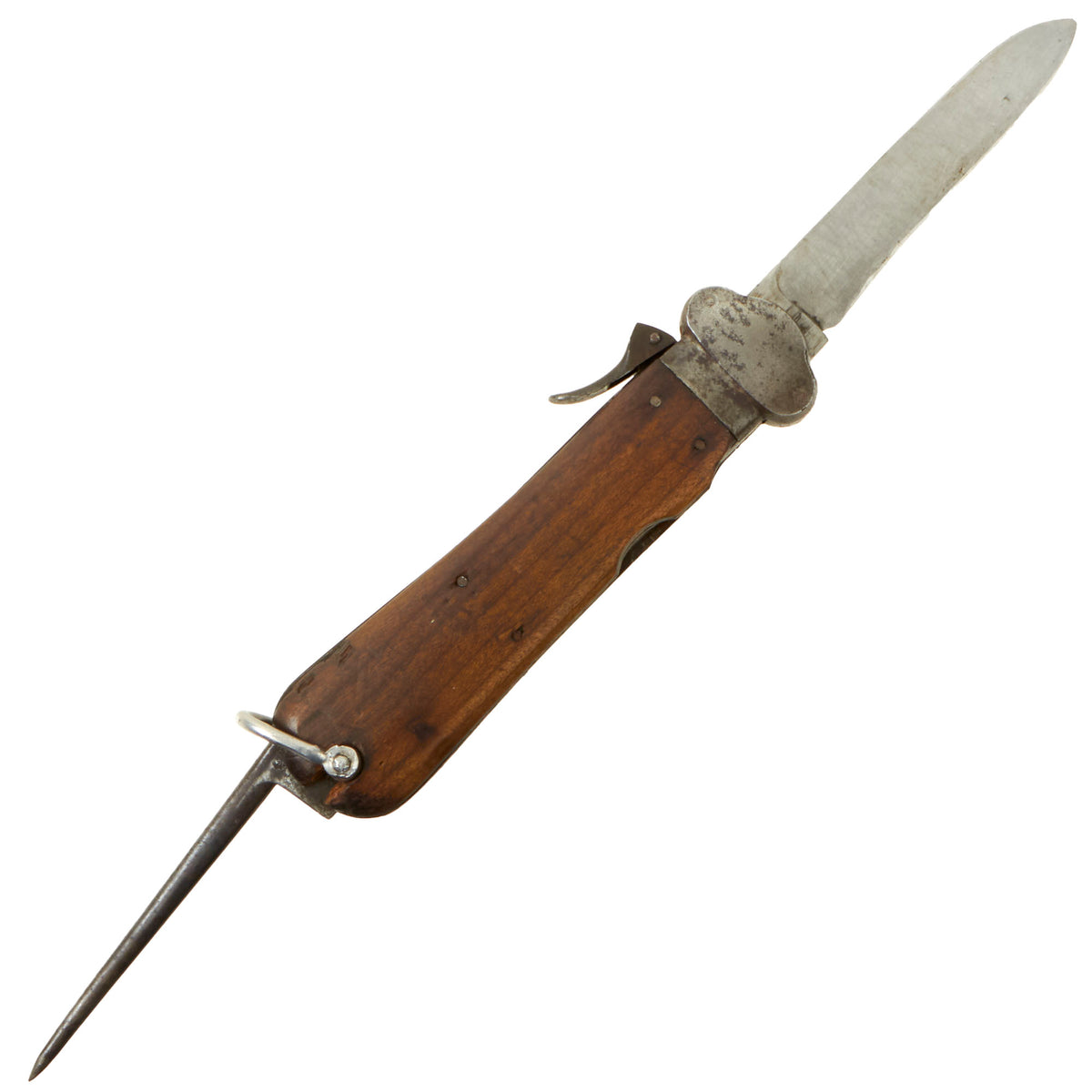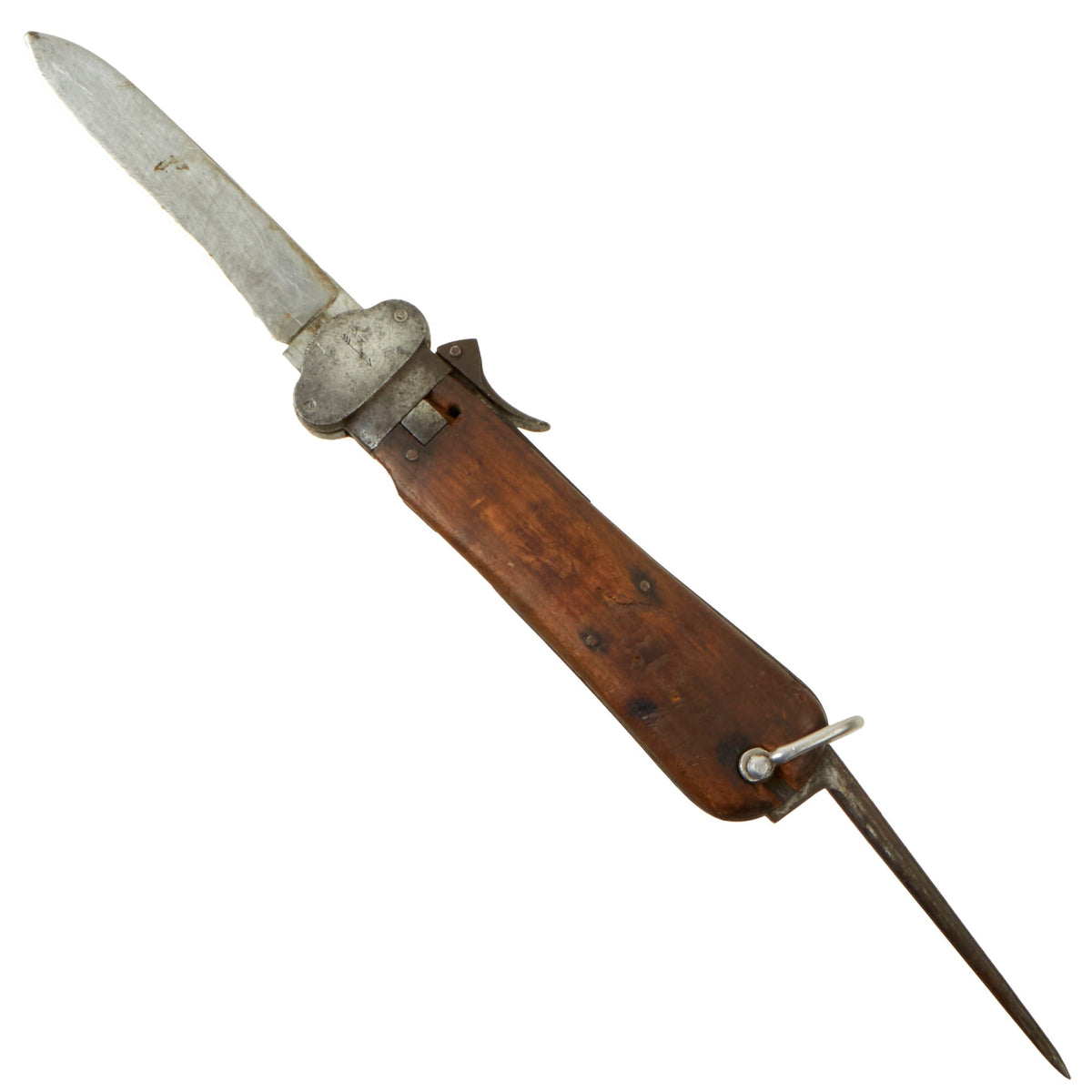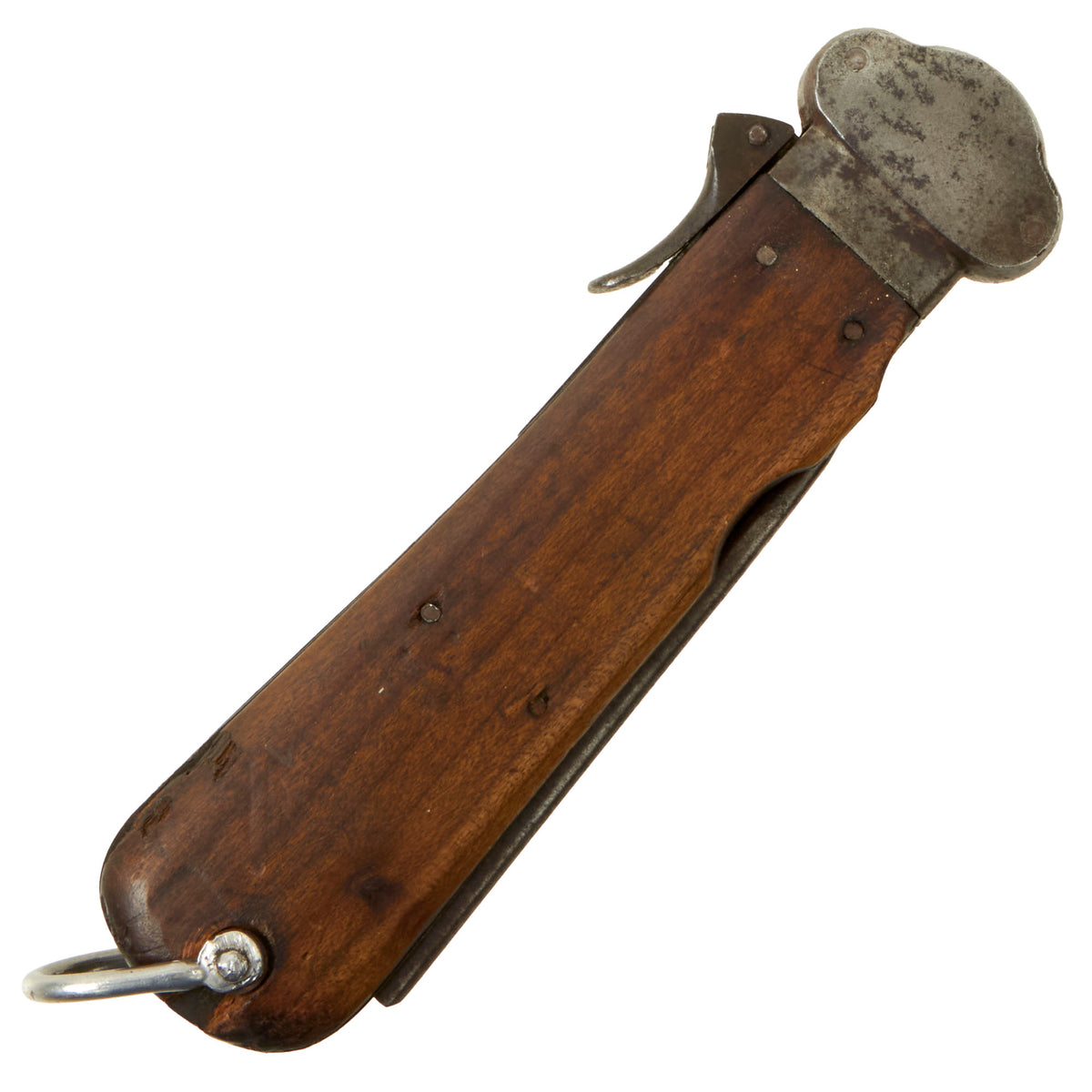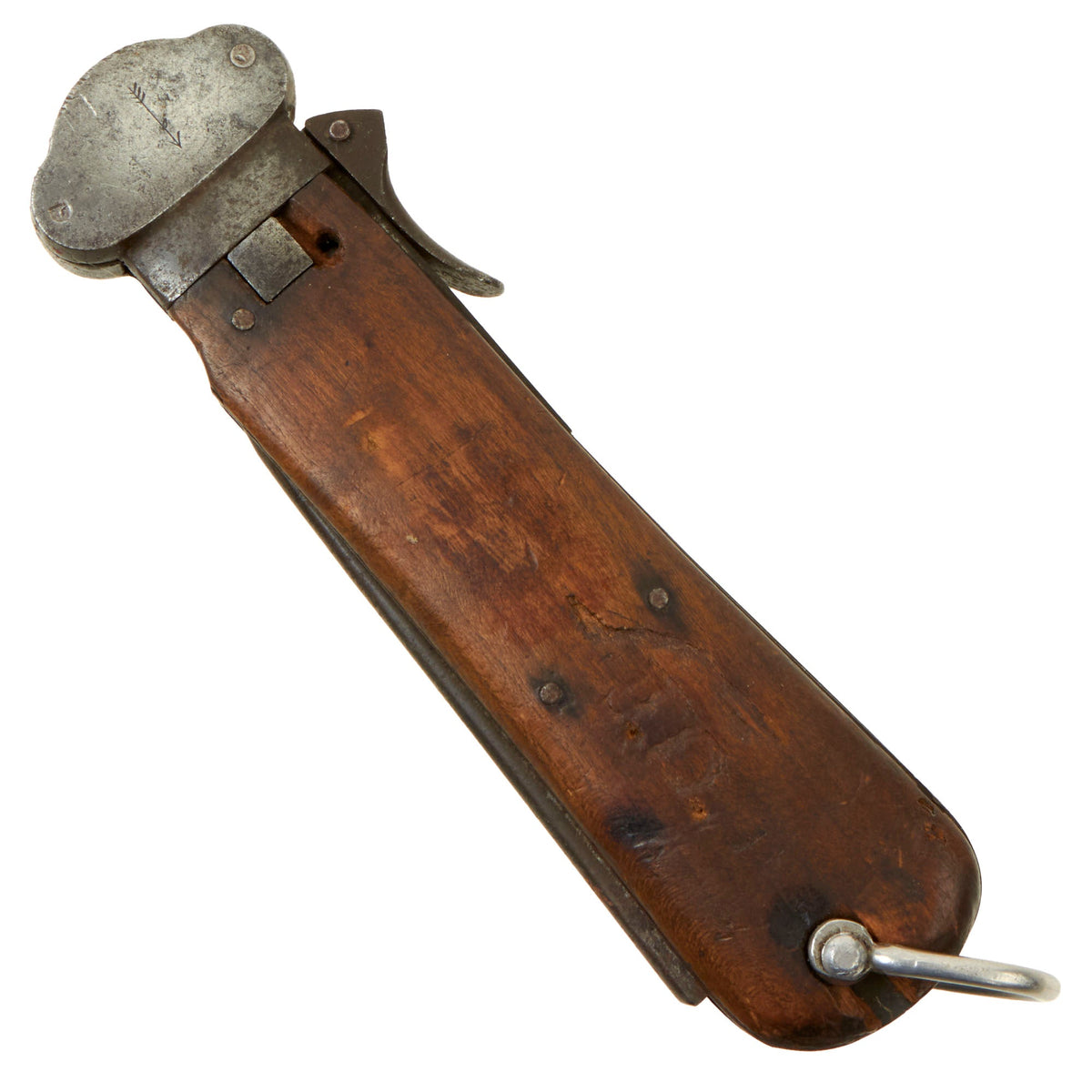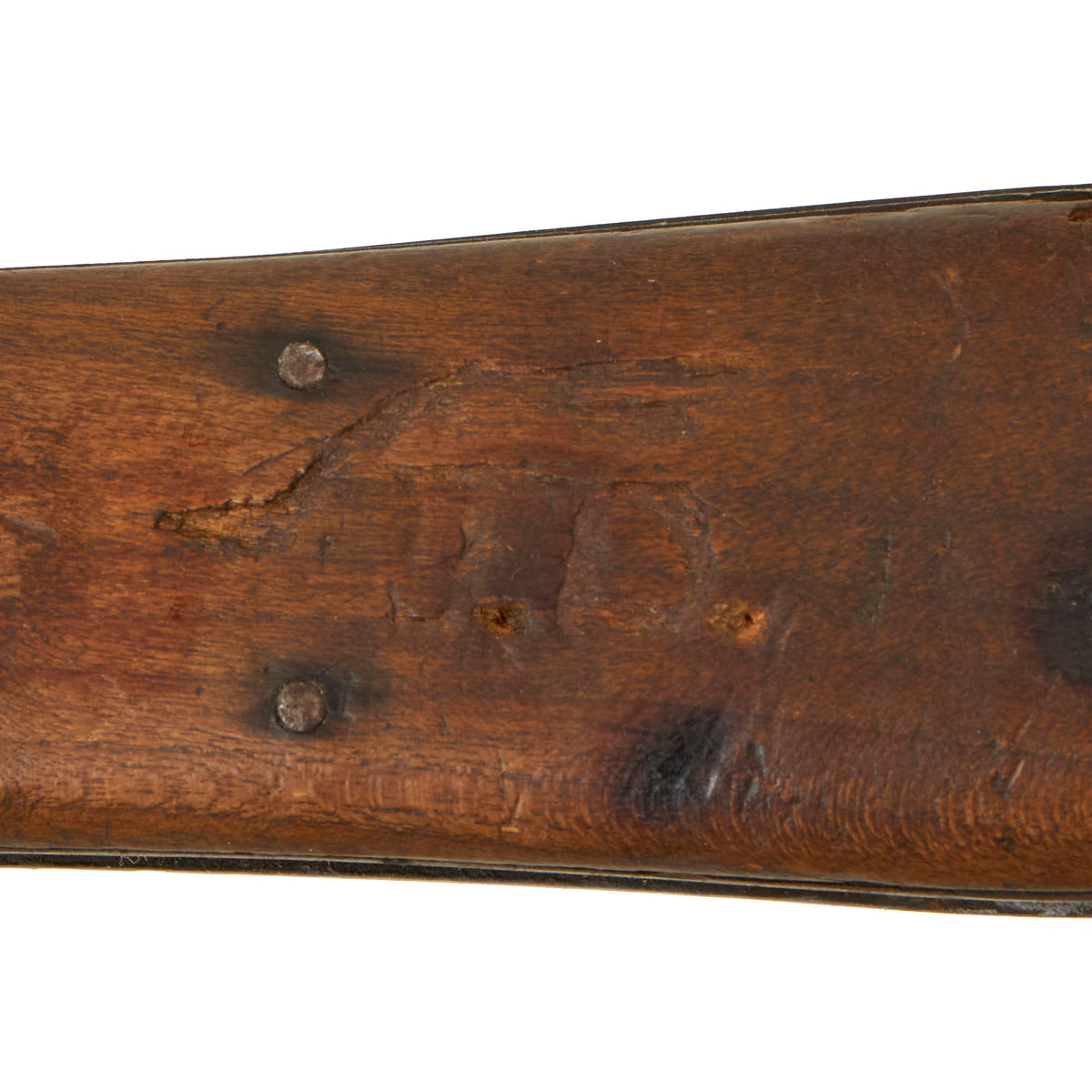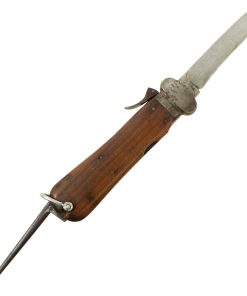Original German WWII Late War Luftwaffe Take Down Fallschirmjäger Gravity Knife – Service Worn Original Items
$ 495,00 $ 148,50
Original Item: Only One Available. This is a nice “salty” service used example of a late-war produced Type II “Take down” version of the legendary Luftwaffe Fallschirmjäger-Messer, or German air force paratrooper knife (FJM or FKm), with a Solingen RB Nr on the blade. These knives utilize a four-inch (100 mm) telescoping (OTF), gravity-propelled locking blade. First produced in 1937, the FJM was issued to German flight crews and paratroops, primarily for the purpose of cutting a trapped parachutist from his rigging in case he landed with a tangled parachute, or became entangled in trees with the shroud lines. Though not intended for use as a fighting knife, the FJM’s blade could be and was used as a close combat weapon when necessary.
The Luftwaffe Fallschirmjäger-Messer uses a sliding blade inside a metal grip frame, which was originally fitted with smooth wood scales, usually of beech or walnut. The blade itself is a relatively blunt spear-point, and the profile is flat ground, tapering to a utility edge. To open the blade, the user points the FJM downwards while flipping up the fulcrum-style operating lever, allowing gravity to draw out the blade to its fullest extent. Releasing the lever locks the blade into position. The FJM may also be opened by flipping the blade release lever while flicking the wrist holding the knife, causing the blade to extend. The FJM was also equipped with a folding marlinspike or awl. Primarily intended for untangling rope knots, it can also be used as a prying tool. The FJM’s spike does not lock when opened and was never intended to be used as a combat weapon, though individual German paratroopers may have employed it as such.
There are three principal types of wartime-era Luftwaffe Fallschirmjäger-Messers. The Type I FKm has wood scales (handle), was made from 1937-1941, and unlike successive models, has no ‘takedown’ capability. The Type II FKm is the same knife, but with takedown features, and was produced from 1941 to the end of World War II.
This example of the Type II FKm (FJM) is in well-used condition, and looks to have had parts swapped during its long service life. The blade itself is marked with 315, while one side of the handle is marked 6 6 as well as 8. The marking on the bottom of the crossguard is too work to read, and the latch is marked with 52, which matches the number on the spring latch bolster. There is also an arrow on the cross guard and interior to indicate the correct orientation when reassembling the knife. The base of the marlinspike has a Weimar style Stick Eagle / 5, the standard Luftwaffe inspection mark on knives. There are no maker marks visible on the knife anywhere, and we suspect it was originally marked on the blade.
The “take-down” ability allows the cross guard to be removed, and the body/sheath opens with the end ring as a hinge. The blade can then be removed for servicing, and the interior can be cleaned to ensure the blade moves freely. In this example, the take-down ability functions well, and the release and marlinspike springs are intact with no cracks, however the release spring is loose. Due to this as well as due to wear, the blade no longer locks securely in place, and also needs to be pulled out by hand to extend fully.
The blade has definitely been used and cleaned to remove oxidation, and then some. 1/8″ of length has been removed, and the blade profile is significantly different than when new, having lost a good amount of width. The very tip is broken, and about half an inch in from that there is a bend. The fittings on the knife still display some of the original “anodized” finish, but for the most part show an oxidized patina now.
The grip plates are of walnut with the standard four retaining rivets on each side. These plates are in good condition, showing wear from service. Both sides have chunks missing next to the loop on the bottom, and the left side grip is personalized with J.D., and is also missing the one of the rivets by the cross guard, as well as some of the wood. There are also dents and some stress cracks scattered around the wood.
The take-down version of the gravity knives are becoming extremely difficult to locate, and this is a nice “salty service used example. Ready to display!
Specifications:-
Blade Length: 3 7/8″
Blade Style: Single Edged Knife
Overall length: 10“
Crossguard: 1 1/2″
Fast Shipping with Professional Packaging
Thanks to our longstanding association with UPS FedEx DHL, and other major international carriers, we are able to provide a range of shipping options. Our warehouse staff is expertly trained and will wrap your products according to our exact and precise specifications. Prior to shipping, your goods will be thoroughly examined and securely secured. We ship to thousands clients each day across multiple countries. This shows how we're dedicated to be the largest retailer on the internet. Warehouses and distribution centres can be located throughout Europe as well as the USA.
Note: Orders with more than one item will be assigned a processing date depending on the item.
Before shipping before shipping, we'll conduct a thorough inspection of the items you have ordered. Today, the majority of orders will be delivered within 48 hours. The delivery time will be between 3-7 days.
Returns
The stock is dynamic and we cannot completely manage it because multiple stakeholders are involved, including our factory and warehouse. So the actual stock may alter at any time. It's possible that you may not receive your order once the order has been made.
Our policy is valid for a period of 30 days. If you don't receive the product within 30 days, we are not able to issue a refund or an exchange.
You can only return an item if it is unused and in the same state as the day you received it. You must have the item in its original packaging.
Related products
Uncategorized
Uncategorized
Australian WWII Owen MK1 Machine Carbine SMG Custom Fabricated Replica with Sling Original Items
Uncategorized
Uncategorized
Armored Burgonet Helmet & Polearm from Scottish Castle Leith Hall Circa 1700 Original Items
Uncategorized
Uncategorized
Band of Brothers ORIGINAL GERMAN WWII Le. F.H. 18 10.5cm ARTILLERY PIECE Original Items
Uncategorized
Uncategorized
Uncategorized
Uncategorized
Uncategorized
Uncategorized
Uncategorized
Uncategorized
Uncategorized
Angolan Rebel 1970s era 60mm Inert Display Mortar from Angolan Civil War Original Items
Uncategorized
Uncategorized
Uncategorized
Uncategorized
Uncategorized
